The World's 7 Most Interesting Eggs
Eggs Galore
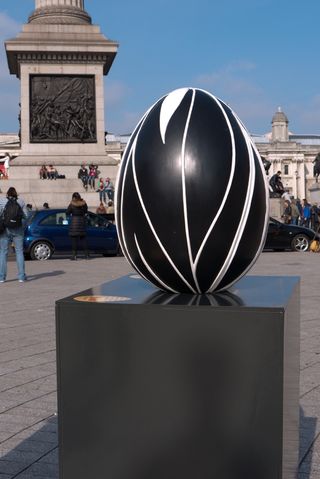
Some are made of precious gems and have storied pasts while others are preserved with a mix of chemicals to create a delicacy and still others developed into chicks of the planet's largest bird, eggs are a scrambled bag, each with its own story to tell.
Read on to find out how eggs have taken center stage in history, folklore and even pop culture. Make sure not to miss the tale of an immortal who stored his heart in one of these eggs. Oh yes, and an egg so large it could house 15 dozen chicken's eggs inside.
(Shown here, one of the giant fiberglass eggs designed by artists and celebrities for the Big Egg Hunt, a fundraiser sponsored by the jeweler Faberge, on March 11, 2012, in London.)
Century Egg
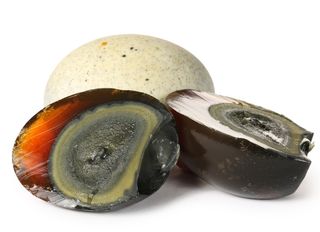
Apparently wine isn't the only food that ages well … eggs do too, if given the royal treatment. And that's just what goes into preserving a Chinese delicacy called the century egg (or pidan). The chemistry of creating a century egg comes down to a reaction between a strong alkaline substance and the egg white's protein called albumen. The reaction turns the egg white into a gelatin, according to "Egg Science and Technology, Fourth Edition" (CRC Press, 1995).
Hydrogen sulfide released as the egg-white protein decomposes reacts with the iron in the egg's yolk, resulting in the dark-green hue of the egg's center, according to "Asian Foods: Science and Technology"(Technomic Publishing, 1999). The resulting cured egg has a transparent brown, jellylike covering that supposedly tastes salty, and a creamy greenish yolk that has a strong flavor, according to various online sources. A History Channel description describes the taste as "sharp, astringent and slightly mineral"
Interested in whipping up a century egg? A 1916 recipe involves covering duck eggs with a mixture of salt, wood ashes and lime added to an infusion of strong black tea. After being stored for five months, the eggs, whose whites and yolks have coagulated, are covered in rice hulls, according to that recipe.
Elephant bird
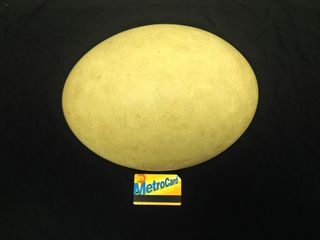
The award for laying the largest functional egg goes to the elephant bird, which is also the largest bird to ever walk the planet. The biggest of this genus (Aepyornis) of extinct birds, the great elephant bird (A. maximus), stood at 10 feet (3 meters) tall and tipped the scales at 880 lbs. (400 kg). More than 2,000 years ago, the island of Madagascar served as the birds' stomping ground. True to its name, the gargantuan bird laid "elephant-size" eggs about the size of American footballs — about 11 inches (28 centimeters) long, with a volume of 300 ounces, or 15 dozen chicken's eggs, according to the Museum Victoria in Australia. The closest living relative of the elephant bird, the small kiwi, did not boast such outsized eggs.
(The littlest egg-layers are hummingbirds with eggs about the size of Tic Tacs and weighing less than a paperclip, according to Paul Sweet, the ornithology collection manager at the American Museum of Natural History in New York.)
Vegreville Pysanka
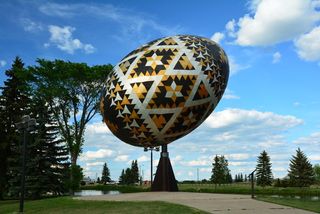
The elephant bird doesn't have anything on what is considered the world's largest Easter egg. OK, so this one is not real, but the Pysanka (a traditionally decorated Ukrainian Easter egg) in Vegreville, Alberta, Canada, towers at 31 feet high, 25.7 feet long and 18 feet wide (9.5 by 7.8 by 5.5 meters), welcoming visitors on the Yellowhead Highway. Built in 1974 to celebrate the centennial of the Royal Canadian Mounted Police, the egg was meant to symbolize harmony and vitality, according to the town's online visitor center.
The late Ronald Resch of the University of Utah conceived and designed the egg using geometric modeling software. The egg's shell, a 2,000-pound (900 kilograms) aluminum skin, envelops its massive "yolk," or an internal structure weighing 3,000 lbs. (1,400 kg). The giant egg sits on a slab of concrete and steel weighing 27,000 lbs. (12,300 kg). The outer skin is attached to a central mast that's tilted so that the entire egg turns in the wind like a "weathervane," according to the the town of Vegreville.
The egg of immortality
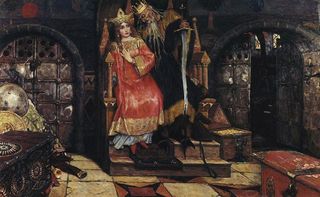
Some eggs are big only in the tales they've spun. In Slavic folklore, Koschei the Deathless, who is unable to die due to the spell he cast to protect himself from harm. Legend has it that Koschei, who has been described as "ugly" and a "shape-shifter," maintained his immortality by placing his heart in a needle inside of an egg (in a duck and in a rabbit) and then locking that egg inside a chest, according to Ancient Origins.
The legendary figure was said to ride naked on an enchanted horse through the mountains of Russia.
Egg-centrics

Reptiles and birds aren't the only egg-layers in town. Also claiming this hatch-a-baby ability is an oddball group of animals called monotremes, whose living members include the duck-billed platypus and four species of echidna (also called spiny anteaters), according to the University of California Museum of Paleontology (UCMP). Representing the only mammals to lay eggs, monotremes are equipped with just one hole (and hence their name, which means "one-holed") called a cloaca for excreting waste and reproducing, according to the University of Edinburgh.
Scientists think that some monotremes survived after their pouched cousins, the marsupials, arrived on the scene between 71 million and 54 million years ago, because they could swim. Those water skills meant monotreme ancestors could seek refuge where marsupials couldn't follow.
The Egg

This egg was "in the oven" for 12 years before it was ready to hatch. Construction of The Egg, a sculpturelike building in Albany, New York, designed by Wallace Harrison, began in 1966 and wasn't completed until 1978, according to the center's website.
Aboveground, it looks like a massive longitudinal half of an egg, made of concrete, but the stem on which the egg structure sits actually extends six stories beneath the ground. Rather than a yolk-y center, this "egg" houses two theaters used for various concerts and performances.
"The building's curved exterior defines the interior statement as well. There are virtually no straight lines or harsh corners inside The Egg," according to the center's website.
Faberge eggs
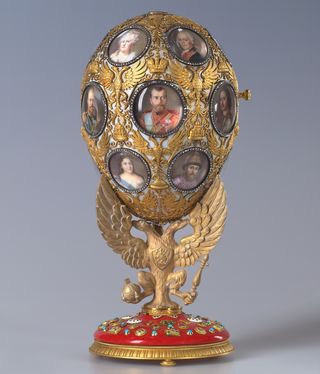
Perhaps the most famous of the bunch, Faberge eggs date back to 1885 when the czar of Russia, Alexander III, commissioned goldsmith Peter Carl Fabergé, of the jewelry company with his name, to create a gold egg as an Easter gift for his wife, Empress Marie Feodorovna, possibly also to celebrate their 20th wedding anniversary, according to Faberge.com. The creation, called the Hen Egg and which became the first of a line of Imperial Eggs, boasted a nesting-doll like structure: its white-gold shell opened to reveal a yellow-gold yolk, which itself opened to show a solid-gold hen, inside of which a tiny diamond replica of the imperial crown was nestled. Each subsequent year until 1917, an Imperial Egg was created for the Russian Imperial family.
When Fabergé died in Switzerland after fleeing Russia during the revolution, his family apparently lost the rights to the company name, though that brand was "reunited" with the family in 2007, according to Faberge.com. Today, the exquisite million-dollar eggs are sold at exclusive boutiques in New York, London and Geneva, their outsides painted with gorgeous gemstones.
Sign up for the Live Science daily newsletter now
Get the world’s most fascinating discoveries delivered straight to your inbox.

Jeanna served as editor-in-chief of Live Science. Previously, she was an assistant editor at Scholastic's Science World magazine. Jeanna has an English degree from Salisbury University, a master's degree in biogeochemistry and environmental sciences from the University of Maryland, and a graduate science journalism degree from New York University. She has worked as a biologist in Florida, where she monitored wetlands and did field surveys for endangered species. She also received an ocean sciences journalism fellowship from Woods Hole Oceanographic Institution.
